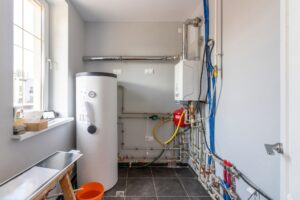Understanding Radiant Heating Systems

There are several types of heating systems available for homeowners, and each uses their own approach to heating the home. Ductless heat pumps, hybrid heaters, gas furnaces, traditional heat pumps… With that much variation, they can’t all possibly satisfy every individual homeowner’s needs and preferences. However, many homeowners do agree that radiant heating systems offer unmatched heating—in both efficiency and comfort.
Below are some of the reasons why that might be, along with a quick rundown on what makes radiant heating systems unique.
What Are Radiant Heating Systems?
The term “radiant heating” doesn’t refer to a heating system in itself, but a method of heating. Radiant heating warms bodies by transmitting heat through solid objects. Campfires, light bulbs, grills, and even hot cups of coffee are all examples of radiant heating in action.
A system that uses radiant heating has to utilize this process. One common, effective way of doing that is through the use of equipment installed underneath the floors of the home. This equipment—usually a system of pipes or wires—is heated through water or electricity, and that heat then rises up through the room to give the occupants warmth.
What Makes Them Different?
Compare this to forced-air heating systems, such as furnaces or heat pumps, which blow hot air into a room. The problem with forced-air is that it can make the air dry, as well as blow around dust and create conditions that aggravate allergy symptoms. There’s also the chance that damaged ductwork can create uneven heating through the room, as well as potentially waste energy and money.
Radiant heating doesn’t come with these problems because it doesn’t heat the air. Plus, many people say that radiant simply feels better. This has given radiant heating systems a reputation of being one of the more comfortable and efficient heating systems on the market.
What Are the Options for Installation?
Installing a radiant heating system might be an easy and obvious choice for some homes, but it isn’t always a straightforward process. That’s why it’s important to get a full inspection and estimate from a professional of HVAC services in the Bronx before making any commitments to a brand-new heating system.
Preexisting Ductwork
If a homeowner already has their home configured for a forced-air system such as a heat pump, it might be wiser to stick to that system. The time and money required to retrofit a home with a radiant heating system might be out of the normal homeowner’s budget.
Boiler, but No Flooring
Radiant heating systems require either natural gas or electricity as a fuel source. In the case of electricity, the components are heated by electrical resistance. For natural gas, however, the system does require a boiler installation to heat the water that will flow through the pipes of the radiant heating system.
Some homeowners may compromise by choosing not to have the in-floor system installed, opting to use baseboard heaters or radiators instead. However, to truly take advantage of the best radiant heating has to offer, it’s recommended to install the in-floor system if possible.







